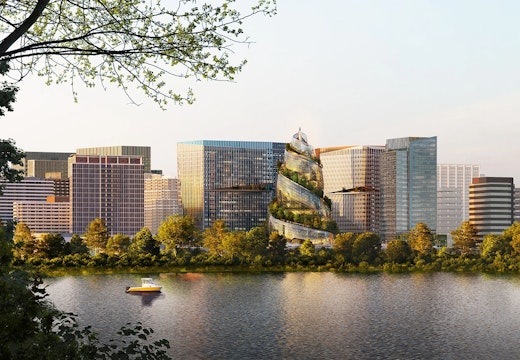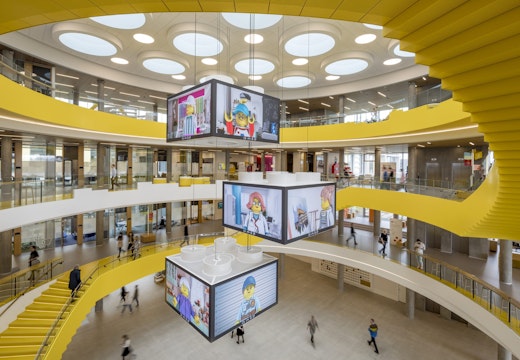Will Jaguar rebrand show the limits of the corporate makeover?
In seeking out a new audience with a more modern, inclusive and sustainable offer, Jaguar’s eye-catching makeover holds some key lessons for developers and designers in the office sector
There can be few corporate rebrands in living memory that have attracted so much polarising comment and controversy as Jaguar’s decision to ditch its traditional heritage in favour of a radical new look.
The global business world has been royally entertained by the sight of a famously admired but commercially frail British icon of automobile design going for broke in search of a new audience in the era of the electric vehicle.
Jaguar’s launch at Miami Art Week of an EV concept car, the Type 00, in shocking ‘Miami pink’ (there is also a ‘London blue’ model) has been backed up by a teaser advertising campaign of ‘fearless creativity’ featuring an ambiguous set of colourful, inclusive, androgynous figures but no wheels on the road. Even Elon Musk joined the debate on X, asking: ‘Do you sell cars?’
Bigger issue at stake
In terms of winning huge amounts of free publicity, Jaguar’s bold departure has already done its job. Everyone has been talking about – and writing about – a car brand that was tired, irrelevant and largely ignored just a month ago. But behind all the hype and the headlines, there is a bigger issue at stake that will be very familiar to those who work in design and marketing, especially in corporate real estate.
The issue is this: when revamping any design asset and unveiling a new look or strategy, how radical should you be prepared to go and what are the limits? Jaguar faced this dilemma in trying to attract the attention of a younger generation of drivers of premium, high-end EVs for whom E-Type Jag nostalgia with walnut dash, leather seats and a large boot for a set of golf clubs is today ancient history.

Image courtesy of BBC, Jaguar Type 00 and Jaguar E-Type.
Lost its lustre
Consider the parallel with office developers, landlords and occupiers who are seeking to remake their bonds with a new audience for whom the traditional workplace has lost its lustre in a hybrid age of more choice and flexibility. Offices, like cars, need to be more sustainable and inclusive. The return to the office has been slow and tricky, especially in larger firms, and few dispute the need for radical solutions to make corporate HQs and central business districts more desirable. But how radical should the real-estate players go?
Different organisations have tried different things without quite hitting the level of ‘fearless creativity’ advocated by Jaguar’s design chief Gerry McGovern. Lego, for instance, revamped its new Danish headquarters in Billund with a radical blueprint to devote two-thirds of its new facility to collaboration and socialising, and only a third to traditional desking. However, the toy maker retained familiar elements of its brand in the overall design.
When the owners of San Francisco’s 1972-built Transamerica Pyramid in the city’s financial district opted for a radical US $1 billion revamp of their high-profile asset, the designers Foster and Partners completely transformed the interior spaces and outdoor gardens but left the iconic façade untouched.
Remodelling towers
It’s true that car exteriors are much easier to remodel than giant office towers but that hasn’t stopped Canary Wharf in London announcing a scheme to completely remodel the HSBC tower at 8 Canary Square once the bank moves out in 2027 as part of plans to give the struggling business district a major overhaul. The project designed by architects Kohn Pedersen Fox will see sections of the building’s façade carved out to create terraces and transform the tower into a mixed-use facility with a public viewing gallery and other leisure facilities.
‘Will more real estate players take a giant artistic leap in workplace design?’
If carving large chunks out of skyscrapers to create sky gardens sounds radical, Google’s focus on adaptive reuse takes the rebranding of workplace a stage further. Its skilful conversion of two of New York City’s most iconic sites – St John’s Rail Terminal and Pier 57 – to create destination office space shows what can be achieved with creative vision.
Will more real estate players be willing to take a giant artistic leap in workplace design? According to a new report from the Urban Land Institute and professional services giant PwC, radical ideas are certainly needed to rescue many of Europe’s ‘stranded’ office assets.
But what we’re unlikely to see in workplace is the audacious no-holds-barred extent of Jaguar’s ‘copy nothing’ approach to the EV market. Transformation will be more partial and balanced, and the results may be more impactful as a result.








